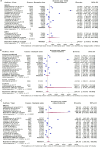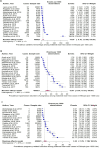Prevalence, underlying causes, and determinants of maternal near miss in Ethiopia: a systematic review and meta-analysis
- PMID: 39440038
- PMCID: PMC11493713
- DOI: 10.3389/fmed.2024.1393118
Prevalence, underlying causes, and determinants of maternal near miss in Ethiopia: a systematic review and meta-analysis
Abstract
Background: Maternal near miss (MNM) is one of the newly adopted assessment parameters to gauge the quality of maternity care. In Ethiopia, several studies have been conducted to investigate the incidence, underlying causes, and determinants of MNM. However, the findings from those studies vary greatly and are largely inconsistent. Thus, this review aims to more robustly estimate the pooled prevalence, identify underlying causes, and single out determinants of MNM in Ethiopia.
Methods: Studies were searched from international databases (PubMed/ Medline, Cochrane Library, and Embase databases) and other potential sites. All observational studies were included. Heterogeneity between studies was checked using Cochrane Q test statistics and I2 test statistics and small study effects were checked using Egger's statistical test at a 5% significance level. Outcome measures were overall and specific underlying causes (obstetrics hemorrhage, hypertensive disorder pregnancy, pregnancy-related infection) rates of MNMs per 10,000 live births.
Result: The meta-analysis included 43 studies consisting of 77240 MNM cases. The pooled prevalence MNM per 1000 live births in Ethiopia was 54.33 (95% CI: 33.93 to 85.89). Between-study heterogeneity was high (I2 = 100%, P < 0.0001), with the highest rate observed in Amhara region (384.54 per 1000). The prevalence of obstetrics hemorrhage (14.56 per 1000) was higher than that of hypertensive disorder pregnancy (12.67 per 1000) and pregnancy-related infections (3.55 per 1000) were identified as underlying causes. Various factors, including socio demographic characteristics, previous medical and obstetrics history as well as access to and quality of care obtained, were associated with MNM.
Conclusion: Almost six women encounter near miss among a hundred live births in Ethiopia. Obstetric hemorrhage and hypertensive disorder pregnancy were the most common underlying causes of MNM. Both individual and facility level determinants were found to be associated with MNM. Considering the magnitude and identified factors, tailored measures should be taken at every stage of the continuum of care.
Systematic review registration: https://www.crd.york.ac.uk/prospero/, identifier CRD42023395259.
Keywords: maternal death surveillance and response; maternal near miss (MNM); pregnancy induced hypertension; puerperal infection; uterine hemorrhage.
Copyright © 2024 Tesfay, Hailu, Begna, Habtetsion, Taye, Woldeyohannes and Jina.
Conflict of interest statement
The authors declare that the research was conducted in the absence of any commercial or financial relationships that could be construed as a potential conflict of interest.
Figures







Similar articles
-
Road to maternal death: the pooled estimate of maternal near-miss, its primary causes and determinants in Africa: a systematic review and meta-analysis.BMC Pregnancy Childbirth. 2024 Feb 17;24(1):144. doi: 10.1186/s12884-024-06325-1. BMC Pregnancy Childbirth. 2024. PMID: 38368373 Free PMC article.
-
Determinants of maternal near miss among women in public hospital maternity wards in Northern Ethiopia: A facility based case-control study.PLoS One. 2017 Sep 8;12(9):e0183886. doi: 10.1371/journal.pone.0183886. eCollection 2017. PLoS One. 2017. PMID: 28886034 Free PMC article.
-
Prevalence and determinants of maternal near miss in Ethiopia: a systematic review and meta-analysis, 2015-2023.BMC Womens Health. 2023 Jul 19;23(1):380. doi: 10.1186/s12905-023-02523-9. BMC Womens Health. 2023. PMID: 37468876 Free PMC article.
-
Incidence of severe maternal outcomes following armed conflict in East Gojjam zone, Amhara region, Ethiopia: using the sub-Saharan Africa maternal near-miss criteria.Front Public Health. 2025 Jan 8;12:1456841. doi: 10.3389/fpubh.2024.1456841. eCollection 2024. Front Public Health. 2025. PMID: 39845662 Free PMC article.
-
Maternal near miss among women admitted in major private hospitals in eastern Ethiopia: a retrospective study.BMC Pregnancy Childbirth. 2021 Mar 5;21(1):181. doi: 10.1186/s12884-021-03677-w. BMC Pregnancy Childbirth. 2021. PMID: 33663429 Free PMC article.
Cited by
-
Inequality in maternal delays related to maternal death at home and en route to a health facility in Ethiopia: insights from national mortality surveillance data.BMJ Open. 2025 Feb 11;15(2):e083962. doi: 10.1136/bmjopen-2024-083962. BMJ Open. 2025. PMID: 39933803 Free PMC article.
-
Implementation status of maternal death surveillance and response system in Ethiopia: Evidence from a national-level system evaluation.PLoS One. 2024 Dec 3;19(12):e0312958. doi: 10.1371/journal.pone.0312958. eCollection 2024. PLoS One. 2024. PMID: 39625947 Free PMC article.
References
-
- World Health Organization. Evaluating the quality of care for severe pregnancy complications: the WHO near-miss approach for maternal health. Geneva: World Health Organization; (2011).
-
- Heemelaar S, Kabongo L, Ithindi T, Luboya C, Munetsi F, Bauer A, et al. Measuring maternal near-miss in a middle-income country: Assessing the use of WHO and sub-Saharan Africa maternal near-miss criteria in Namibia. Glob Health Act. (2019) 12:1646036. 10.1080/16549716.2019.1646036 - DOI - PMC - PubMed
Publication types
LinkOut - more resources
Full Text Sources

